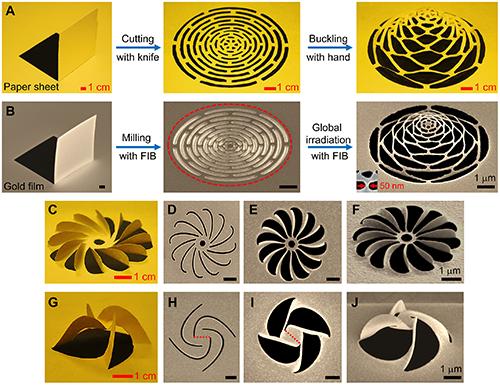Nano-kirigami: 'Paper-cut' provides model for 3D intelligent nanofabrication

Macroscopic paper-cuts in a paper sheet and nano-kirigami in an 80-nm thick gold film. Credit: Institute of Physics
Dr. LI Jiafang, from the Institute of Physics (IOP), Chinese Academy of Sciences, has recently formed an international team to apply kirigami techniques to advanced 3D nanofabrication.
Inspired by a traditional Chinese kirigami design called “pulling flower,” the team developed a direct nano-kirigami method to work with flat films at the nanoscale. They utilized a focused ion beam (FIB) instead of knives/scissors to cut a precise pattern in a free-standing gold nanofilm, then used the same FIB, instead of hands, to gradually “pull” the nanopattern into a complex 3D shape.
The “pulling” forces were induced by heterogeneous vacancies (introducing tensile stress) and the implanted ions (introducing compressive stress) within the gold nanofilm during FIB irradiation.
By utilizing the topography-guided stress equilibrium within the nanofilm, versatile 3D shape transformations such as upward buckling, downward bending, complex rotation and twisting of nanostructures were precisely achieved.
While previous attempts to create functional kirigami devices have used complicated sequential procedures and have been primarily aimed at realizing mechanical rather than optical functions, this new nano-kirigami method, in contrast, can be implemented in a single fabrication step and could be used to perform a number of optical functions.
For a proof-of-concept demonstration, the team produced a 3D pinwheel-like structure with giant optical chirality. The nanodevice achieved efficient manipulation of “left-handed” and “right-handed” circularly polarized light and exhibited strong uniaxial optical rotation effects in telecommunication wavelengths.
In this way, the team demonstrated a multidisciplinary connection between the two fields of nanomechanics and nanophotonics. This may represent a brand new direction for emerging kirigami research.
The team also developed a theoretical model to elucidate the dynamics during the nano-kirigami fabrication. This is of great significance since it allows researchers to design 3D nanogeometries based on desired optical functionalities. In contrast, previous studies relied heavily on intuitive designs.
In other words, in terms of geometric design, nano-kirigami offers an intelligent 3D nanofabrication method beyond traditional bottom-up, top-down and self-assembly nanofabrication techniques.
Its concept can be extended to broad nanofabrication platforms and could lead to the realization of complex optical nanostructures for sensing, computation, micro-/nano- electromechanical systems or biomedical devices.
This work, entitled “Nano-kirigami with giant optical chirality,” was published in Science Advances on July 6, 2018.
###
The study was supported by the National Science Foundation of China, the Ministry of Science and Technology of China, the Chinese Academy of Sciences, the Chinese Scholarship Council and grants from the U.S government.
Media Contact
All latest news from the category: Physics and Astronomy
This area deals with the fundamental laws and building blocks of nature and how they interact, the properties and the behavior of matter, and research into space and time and their structures.
innovations-report provides in-depth reports and articles on subjects such as astrophysics, laser technologies, nuclear, quantum, particle and solid-state physics, nanotechnologies, planetary research and findings (Mars, Venus) and developments related to the Hubble Telescope.
Newest articles

First-of-its-kind study uses remote sensing to monitor plastic debris in rivers and lakes
Remote sensing creates a cost-effective solution to monitoring plastic pollution. A first-of-its-kind study from researchers at the University of Minnesota Twin Cities shows how remote sensing can help monitor and…

Laser-based artificial neuron mimics nerve cell functions at lightning speed
With a processing speed a billion times faster than nature, chip-based laser neuron could help advance AI tasks such as pattern recognition and sequence prediction. Researchers have developed a laser-based…

Optimising the processing of plastic waste
Just one look in the yellow bin reveals a colourful jumble of different types of plastic. However, the purer and more uniform plastic waste is, the easier it is to…


